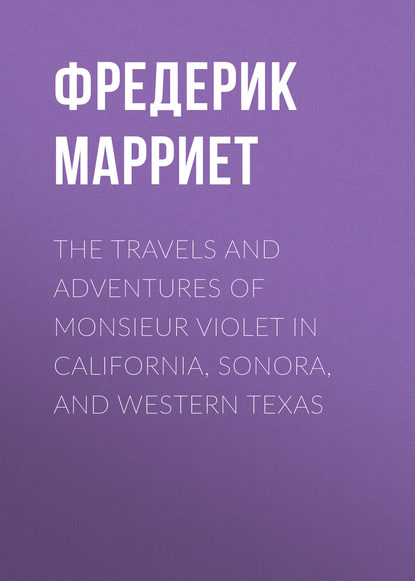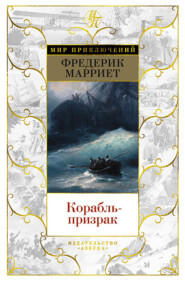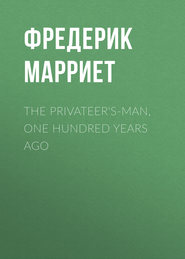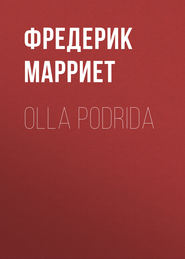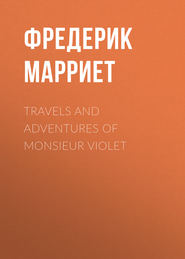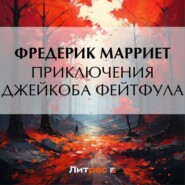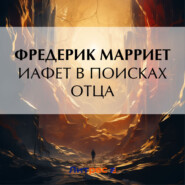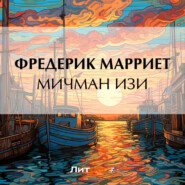По всем вопросам обращайтесь на: info@litportal.ru
(©) 2003-2025.
✖
The Travels and Adventures of Monsieur Violet in California, Sonora, and Western Texas
Автор
Год написания книги
2018
Настройки чтения
Размер шрифта
Высота строк
Поля
"But corn and tobacco must be taken from the earth; they must be watched for many moons, and nursed like children. This is work fit only for squaws and slaves. The Shoshones are warriors and free; if they were to dig in the ground, their sight would become weak, and their enemies would say they were moles and badgers.
"Does the just Nanawa wish the Shoshones to be despised by the Crows or the horsemen of the south? No! he had fought for them before he went to see if the bones of his fathers were safe; and since his return, has he not given to them rifles and powder, and long nets to catch the salmon, and plenty of iron to render their arrows feared alike by the buffaloes and the Umbiquas?
"Nanawa speaks well, for he loves his children: but the spirit that whispers to him is a pale-face spirit, that cannot see under the skin of a red warrior; it is too tough: nor in his blood; it is too dark.
"Yet tobacco is good, and corn too. The hunters of the Flat Heads and Pierced Noses would come in winter to beg for it; their furs would make warm the lodges of the Shoshones. And my people would become rich and powerful; they would be masters of all the country, from the salt waters to the big mountains; the deer would come and lick their hands, and the wild horses would graze around their wigwams. 'Tis so that the pale faces grow rich and strong; they plant corn, tobacco, and sweet melons; they have trees that bear figs and peaches; they feed swine and goats, and tame buffaloes. They are a great people.
"A red-skin warrior is nothing but a warrior; he is strong, but he is poor; he is not a wood-chunk, nor a badger, nor a prairie dog; he cannot dig the ground; he is a warrior, and nothing more. I have spoken."
Of course the tenor of this speech was too much in harmony with Indian ideas not to be received with admiration. The old man took his seat, while another rose to speak in his turn.
"The great chief hath spoken; his hair is white like the down of the swan; his winters have been many; he is wise; why should I speak after him, his words were true? The Manitou touched my ears and my eyes when he spoke (and he spoke like a warrior); I heard his war-cry, I saw the Umbiquas running in the swamps, and crawling like black snakes under the bushes. I spied thirty scalps on his belt, his leggings and mocassins were sewn with the hair of the Wallah Wallahs [1 - Indians living on the Columbian river, two hundred miles above Fort Vancouver, allied to the Nez Percés, and great supporters of the Americans.].
"I should not speak; I am young yet and have no wisdom; my words are few, I should not speak. But in my vision I heard a spirit, it came upon the breeze, it entered within me.
"Nanawa is my father, the father to all, he loves us, we are his children; he has brought with him a great warrior of the pale faces, who was a mighty chief in his tribe; he has given us a young chief who is a great hunter; in a few years he will be a great warrior, and lead our young men in the war-path on the plains of the Wachinangoes[2 - Name given to the half-breeds by the Spaniards, but by Indians comprehending the whole Mexican race.], for Owato Wanisha[3 - The "spirit of the young beaver;" a name given to me when I was made a warrior.] is a Shoshone, though his skin is paler than the flower of the magnolia.
"Nanawa has also given to us two Makota Konayas[4 - Two priests, literally two black gowns.], to teach wisdom to our young men; their words are sweet, they speak to the heart; they know everything and make men better. Nanawa is a great chief, very wise; what he says is right, what he wishes must be done, for he is our father, and he gave us strength to fight our enemies."
"He is right; the Shoshones must have their lodges full of corn and tobacco. The Shoshones must ever be what they are, what they were, a great nation. But the chief of many winters hath said it; the hedge-hogs and the foxes may dig the earth, but the eyes of the Shoshones are always turned towards their enemies in the woods, or the buffaloes in the plains."
"Yet the will of Nanawa must be done, but not by a Shoshone. We will give him plenty of squaws and dogs; we will bring him slaves from the Umbiquas, the Cayuses, and the Wallah Wallahs. They shall grow the corn and the tobacco while we hunt; while we go to fetch more slaves, even in the big mountains, or among the dogs of the south, the Wachinangoes. I will send the vermilion[5 - When a chief wishes to go to war, he sends to his warriors some leaves of tobacco covered with vermilion. It is a sign that they must soon be prepared.] to my young warriors, they will paint their faces and follow me on the war-path. I have spoken!"
Thus ended the hopes of making agriculturists of the wild people among whom we lived; nor did I wonder; such as they were, they felt happy. What could they want besides their neat conical skin lodges, their dresses, which were good, comfortable, and elegant, and their women, who were virtuous, faithful, and pretty? Had they not the unlimited range of the prairies? were they not lords over millions of elks and buffaloes?–they wanted nothing, except tobacco. And yet it was a pity we could not succeed in giving them a taste for civilization. They were gentlemen by nature; as indeed almost all the Indians are, when not given to drinking. They are extremely well bred, and stamped with the indubitable seal of nobility on their brow.
The council was broken up, as both Christianity and his own peculiar sentiments would not permit the Prince Seravalle to entertain the thought of extending slavery. He bowed meekly to the will of Providence, and endeavoured by other means to effect his object of enlightening the minds of this pure and noble, yet savage race of men.
CHAPTER III
This breaking up, for the time, of our agricultural settlement took place in the year 1838. Till then, or a few months before, I had passed my time between my civilized and uncivilized instructors. But although educated, I was an Indian, not only in my dress but in my heart.
I mentioned that in the council called by the Prince I was present, having been admitted as a chief, being then about seventeen years old. My admission was procured in the following manner: when we received intelligence of the murder, or disappearance of our seven white men, whom the Prince had sent to Monterey to procure cattle, a party was sent out on their track to ascertain what had really taken place, and at my request the command of that party was confided to me.
We passed the Buona Ventura, and followed the track of our white men for upwards of 200 miles, when we not only could trace it no further, but found our small party of fifteen surrounded by about eighty of our implacable enemies, the Crows.
By stratagem, we not only broke through them, but succeeded in surprising seven of their party. My companions would have put them to death, but I would not permit it. We secured them on their own horses, and made all the haste we could, but the Crows had discovered us and gave chase.
It was fifteen days' travelling to our own country, and we were pursued by an enemy seven or eight times superior to us In numbers. By various stratagems, which I shall not dwell upon, aided by the good condition of our horses, we contrived to escape them, and to bring our prisoners safe into the settlement. Now, although we had no fighting, yet address is considered a great qualification. On my return I was therefore admitted as a chief, with the Indian name Owato Wanisha, or "spirit of the beaver," as appropriate to my cunning and address. To obtain the rank of a warrior chief, it was absolutely requisite that I had distinguished myself on the field of battle.
Before I continue my narration, I must say a little more relative to the missionaries, who were my instructors. One of them, the youngest, Polidori, was lost in the Esmeralda, when she sailed for Monterey to procure cattle. The two others were Padre Marini and Padre Antonio. They were both highly accomplished and learned. Their knowledge in Asiatic lore was unbounded, and it was my delight to follow them in their researches and various theories concerning the early Indian emigration across the waters of the Pacific.
They were both Italians by birth. They had passed many years of their lives among the nations west of the Ganges, and in their advanced years had returned to sunny Italy, to die near the spot where they had played as little children. But they had met with Prince Seravalle, and when they heard from him of the wild tribes with whom he had dwelt, and who knew not God, they considered that it was their duty to go and instruct them.
Thus did these sincere men, old and broken, with one foot resting on their tombs, again encounter difficulties and danger, to propagate among the Indians that religion of love and mercy which they were appointed to make known.
Their efforts, however, to convert the Shoshones were fruitless. Indian nature would seem to be a nature apart and distinct. The red men, unless in suffering or oppression, will not listen to what they call "the smooth honey words of the pale-faced sages;" and even when they do so, they argue upon every dogma and point of faith, and remain unconvinced. The missionaries, therefore, after a time, contented themselves with practising deeds of charity, with alleviating their sufferings when able, from their knowledge of medicine and surgery, and by moral precepts, softening down as much as they could the fierce and occasionally cruel tempers of this wild untutored race.
Among other advantages which the Shoshones derived from our missionaries, was the introduction of vaccination. At first it was received with great distrust, and indeed violently opposed, but the good sense of the Indians ultimately prevailed: and I do not believe that there is one of the Soshones born since the settlement was formed who has not been vaccinated: the process was explained by the Padres Marini and Polidori to the native medical men, and is now invariably practised by them.
I may as well here finish the histories of the good missionaries. When I was sent upon an expedition to Monterey, which I shall soon have to detail, Padre Marini acccompanied me. Having failed with the Shoshones, he considered that he might prove useful by locating himself in the Spanish settlements of California. We parted soon after we arrived at Monterey, and I have never seen or heard of him since. I shall, however, have to speak of him again during our journey and sojourn at that town.
The other, Padre Antonio, died at the settlement previous to my journey to Monterey, and the Indians still preserve his robes, missal, and crucifix, as the relics of a good man. Poor Padre Antonio! I would have wished to have known the history of his former life. A deep melancholy was stamped upon his features, from some cause of heart-breaking grief, which even religion could but occasionally assuage, but not remove.
After his death, I looked at his missal. The blank pages at the beginning and the end were filled up with pious reflections, besides some few words, which spoke volumes as to one period of his existence. The first words inscribed were; "Julia, obiit A.D. 1799. Virgo purissima, Maris Stella. Ora pro me." On the following leaf was written: "Antonio de Campestrina, Convient. Dominicum. in Româ, A.D. 1800."
Then he had embraced a monastic life upon the death of one dear to him–perhaps his first and only love. Poor man! many a time have I seen the big burning tears rolling fast down his withered cheeks. But he is gone, and his sorrows are at rest On the last page of the missal were also two lines, written in a tremulous hand, probably a short time previous to his death: "I, nunc anima anceps; sitque tibi Deus misericors."
The Prince Seravalle did not, however, abandon his plans; having failed in persuading the Shoshones, at the suggestion of my father, it was resolved that an attempt should be made to procure a few Mexicans and Canadians to carry on the agricultural labours; for I may here as well observe, that both the Prince and my father had long made up their minds to live and die among the Indians.
This expedition was to be undertaken by me. My trip was to be a long one. In case I should not succeed in Monterey in enlisting the parties required, I was to proceed on to Santa Fé, either with a party of Apaches Indians, who were always at peace with the Shoshones, or else with one of the Mexican caravans.
In Santa Fé there were always a great number of French and Canadians, who came every year from St. Louis, hired by the Fur Companies; so that we had some chance of procuring them. If, however, my endeavours should prove fruitless, as I should already have proceeded too far to return alone, I was to continue on from Santa Fé with the fur traders, returning to St. Louis, on the Mississippi, where I was to dispose of some valuable jewels, hire men to form a strong caravan, and return to the settlement by the Astoria trail.
As my adventures may be said but to commence at my departure upon this commission, I will, before I enter upon my narrative, give the reader some insight into the history and records of the Shoshones, or Snake Indians, with whom I was domiciled, and over whom, although so young, I held authority and command.
CHAPTER IV
The Shoshones, or Snake Indians, are a brave and numerous people, occupying a large and beautiful tract of country, 540 miles from east to west, and nearly 300 miles from north to south. It lies betwixt 38° and 43° north latitude, and from longitude 116° west of Greenwich to the shores of the Pacific Ocean, which there extend themselves to nearly the parallel of 125° west longitude. The land is rich and fertile, especially by the sides of numerous streams, where the soil is sometimes of a deep red colour, and at others entirely black. The aspect of this region is well diversified, and though the greatest part of it must be classified under the denomination of rolling prairies, yet woods are very abundant, principally near the rivers and in the low flat bottoms: while the general landscape is agreeably relieved from the monotony of too great uniformity by numerous mountains of fantastical shapes and appearance, entirely unconnected with each other, and all varying in the primitive matter of their conformation.
Masses of native copper are found at almost every step, and betwixt two mountains which spread from east to west in the parallel of the rivers Buona Ventura and Calumet, there are rich beds of galena, even at two or three feet under ground; sulphur and magnesia appear plentiful in the northern districts; while in the sand, of the creeks to the south gold dust is occasionally collected by the Indians. The land is admirably watered by three noble streams–the Buona Ventura, the Calumet, and the Nú elejé sha wako, or River of the Strangers, while twenty rivers of inferior size rush with noise and impetuosity from the mountains, until they enter the prairies, where they glide smoothly in long serpentine courses between banks covered with flowers and shaded by the thick foliage of the western magnolia. The plains, as I have said, are gently undulating, and are covered with excellent natural pastures of moskito-grass, blue grass, and clover, in which innumerable herds of buffaloes, and mustangs, or wild horses, graze, except during the hunting season, in undisturbed security.
The Shoshones[6 - The American travellers (even Mr. Catlin, who is generally correct) have entirely mistaken the country inhabited by the Shoshones. One of them represents this tribe as "the Indians who inhabit that part of the Rocky Mountains which lies on the Grand and Green River branches of the Colorado of the West, the valley of Great Bear River, and the hospitable shores of the Great Salt Lakes." It is a great error. That the Shoshones may have been seen in the above-mentioned places is likely enough, as they are a great nation, and often send expeditions very far from their homes; but their own country lies, as I have said, betwixt the Pacific Ocean and the 116th degree of west longitude. As to the "hospitable" shores of the Great Salt Lake. I don't know what it means, unless it be a modern Yankee expression for a tract of horrid swamps with deadly effluvia, tenanted by millions of snakes and other "such hospitable reptiles." The lake is situated on the western country of the Crows, and I doubt if it has ever been visited by any Shoshone.] are indubitably a very ancient people. It would be impossible to say how long they may have been settled on this portion of the continent. Their cast of features proves them to be of Asiatic origin, and their phraseology, elegant and full of metaphors, assumes all the graceful variety of the brightest pages of Saadi.
A proof of their antiquity and foreign extraction is, that but few of their records and traditions are local; they refer to countries on the other side of the sea, countries where the summer is perpetual, the population numberless, and the cities composed of great palaces, like the Hindoo traditions, "built by the good genii, long before the creation of man."
There is no doubt, indeed it is admitted by the other tribes that the Shoshone is the parent tribe of the Comanches, Arrapahoes, and Apaches–the Bedouins of the Mexican deserts. They all speak the same beautiful and harmonious language, have the same traditions; and indeed so recent have been their subdivisions, that they point out the exact periods by connecting them with the various events of Spanish inland conquest in the northern portion of Sonora.
It is not my intention to dwell long upon speculative theory, but I must observe, that if any tradition is to be received with confidence it must proceed from nations, or tribes, who have long been stationary. That the northern continent of America was first peopled from Asia, there can be little doubt, and if so, it is but natural to suppose that those who first came over would settle upon the nearest and most suitable territory. The emigrants who, upon their landing, found themselves in such a climate and such a country as California, were not very likely to quit it in search of a better.
That such was the case with the Shoshones, and that they are descendants from the earliest emigrants, and that they have never quitted the settlement made by their ancestors, I have no doubt, for all their traditions confirm it.
We must be cautious how we put faith in the remarks of missionaries and travellers upon a race of people little known. They seldom come into contact with the better and higher classes, who have all the information and knowledge; and it is only by becoming one of them, not one of their tribes, but one of their chiefs, and received into their aristocracy, that any correct intelligence can be gained.
Allow that a stranger was to arrive at Wapping, or elsewhere, in Great Britain, and question those he met in such a locality as to the religion, laws, and history of the English, how unsatisfactory would be their implies; yet missionaries and travellers among these nations seldom obtain farther access. It is therefore among the better classes of the Indians that we must search for records, traditions, and laws. As for their religion, no stranger will ever obtain possession of its tenets, unless he is cast among them in early life and becomes one of them.
Let missionaries say what they please in their reports to their societies, they make no converts to their faith, except the pretended ones of vagrant and vagabond drunkards, who are outcasts from their tribes.
The traditions of the Shoshones fully bear out my opinion that they were among the earliest of the Asiatic emigrants; they contain histories of subsequent emigrations, in which they had to fight hard to retain their lands; of the dispersion of the new emigrants to the north and south; of the increase of numbers, and breaking up of portions of the tribes, who travelled away to seek subsistence in the East.
We find, as might be expected, that the traditions of the Eastern tribes, collected as they have occasionally been previous to their extinction, are trifling and absurd; and why so? because, driven away to the east, and finding other tribes of Indians, who had been driven there before them, already settled there, they have immediately commenced a life of continual hostility and change of domicile. When people have thus been occupied for generations in continual warfare and change, it is but natural to suppose that in such a life of constant action they have had no time to transmit then traditions, and that ultimately they have been lost to the tribe.
We must then look for records in those quarters where the population has remained stationary for ages. It must be in the south-west of Oregon, and in the northern parts of Upper California and Sonora, that the philosopher must obtain the eventful history of vast warlike nations, of their rise and of their fall. The western Apaches or the Shoshones, with their antiquities and ruins of departed glory, will unfold to the student's mind long pages of a thrilling interest, while in their metaphors and rich phraseology, the linguist, learned in Asiatic lore, will easily detect their ancient origin.
It is remarkable to observe, how generally traditions and records will spread and be transmitted among nations destitute of the benefits of the art of printing. In Europe, the mass were certainly better acquainted with their ancient history before this great discovery that they are in our days, as traditions were then handed down from family to family–it was a duty, a sacred one, for a father to transmit them to his son, unadulterated, such, in fact, as he had received them from his ancestors. It is the same case with the Indians, who have remained stationary for a long period. It is in the long evenings of February, during the hunting seasons that the elders of the tribe will reveal to the young warriors all the records of their history; and were a learned European to assist at one of these "lectures upon antiquity," he would admit that, in harmony, eloquence, strength of argument, and deduction, the red-coloured orator could not easily be surpassed.
The Shoshones have a clear and lucid recollection of the far countries whence they have emigrated. They do not allude to any particular period, but they must have been among the first comers, for they relate with great topographical accuracy all the bloody struggles they had to sustain against newer emigrants. Often beaten, they were never conquered, and have always occupied the ground which they had selected from the beginning.
Unlike the great families of the Dahcotahs and Algonquins, who yet retain the predominant characteristics of the wandering nations of South-west Asia, the Shoshones seem to have been in all ages a nation warlike, though stationary. It is evident that they never were a wealthy people, nor possessed any great knowledge of the arts and sciences. Their records of a former country speak of rich mountainous districts, with balmy breezes, and trees covered with sweet and beautiful fruits; but when they mention large cities, palaces, temples, and gardens, it is always in reference to other nations, with whom they were constantly at war; and these traditions would induce us to believe that they are descendants of the Mancheoux Tartars.





